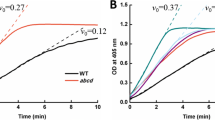Abstract
The acidic stability of a methyl parathion hydrolase (Ochr-MPH) was improved by selectively changing basic amino acids to acidic ones. Mutation sites were selected based on the position-specific amino acid replacement probabilities (more than or equal to 0.2) and the entropy of each site (more than or equal to 0.8). Three mutants (K208E, K277D, and K208E/K277D) were more stable than the wild-type (WT). Their half-lives at pH 5.0 were 64, 68, 65 min, respectively, whereas that of WT was 39 min. The acidic stability of proteins may therefore be improved by changing selected basic amino acid residues to acidic ones.





Similar content being viewed by others
References
Bonisch H, Schmidt CL, Schafer G, Ladenstein R (2002) The structure of the soluble domain of an archaeal Rieske iron-sulfur protein at 1.1 A resolution. J Mol Biol 319:791–805
Brooks BR, Brooks CL 3rd, Mackerell AD Jr, Nilsson L et al (2009) CHARMM: the biomolecular simulation program. J Comput Chem 30:1545–1614
Chen J, Brooks CL 3rd, Khandogin J (2008) Recent advances in implicit solvent-based methods for biomolecular simulations. Curr Opin Struct Biol 18:140–148
Chu X, Wu N, Deng M, Tian J, Yao B, Fan Y (2006) Expression of organophosphorus hydrolase OPHC2 in Pichia pastoris: purification and characterization. Protein Expr Purif 49:9–14
Chu X, Tian J, Wu N, Fan Y (2010) An intramolecular disulfide bond is required for the thermostability of methyl parathion hydrolase, OPHC2. Appl Microbiol Biotechnol 88:125–131
Dong Y, Bartlam M, Sun L, Zhou Y, Zhang Z, Zhang C, Rao Z, Zhang X (2005) Crystal structure of methyl parathion hydrolase from Pseudomonas sp. WBC-3. J Mol Boil 353:655–663
Fushinobu S, Ito K, Konno M, Wakagi T, Matsuzawa H (1998) Crystallographic and mutational analyses of an extremely acidophilic and acid-stable xylanase: biased distribution of acidic residues and importance of Asp37 for catalysis at low pH. Protein Eng 11:1121–1128
Huang Y, Krauss G, Cottaz S, Driguez H, Lipps G (2005) A highly acid-stable and thermostable endo-beta-glucanase from the thermoacidophilic archaeon Sulfolobus solfataricus. Biochem J 385:581–588
Shirai T, Suzuki A, Yamane T, Ashida T, Kobayashi T, Hitomi J, Ito S (1997) High-resolution crystal structure of M-protease: phylogeny aided analysis of the high-alkaline adaptation mechanism. Protein Eng 10:627–634
Spassov VZ, Yan L (2008) A fast and accurate computational approach to protein ionization. Protein Sci 17:1955–1970
Tian J, Wu N, Guo X, Guo J, Zhang J, Fan Y (2007) Predicting the phenotypic effects of non-synonymous single nucleotide polymorphisms based on support vector machines. BMC Bioinformatics 8:450
Tian J, Wang P, Gao S, Chu X, Wu N, Fan Y (2010) Enhanced thermostability of methyl parathion hydrolase from Ochrobactrum sp. M231 by rationally engineering a glycine to proline mutation. FEBS J 277:4901–4908
Turunen O, Vuorio M, Fenel F, Leisola M (2002) Engineering of multiple arginines into the Ser/Thr surface of Trichoderma reesei endo-1,4-beta-xylanase II increases the thermotolerance and shifts the pH optimum towards alkaline pH. Protein Eng 15:141–145
Xiao W, Chu X, Tian J, Guo J, Wu N (2008) Cloning of a methyl parathion hydrolase gene from Ochrobactrum sp. J Agric Sci Technol 10:99–102 In Chinese
Yang J, Yang C, Jiang H, Qiao C (2008) Overexpression of methyl parathion hydrolase and its application in detoxification of organophosphates. Biodegradation 19:831–839
Yang C, Freudl R, Qiao C, Mulchandani A (2010) Cotranslocation of methyl parathion hydrolase to the periplasm and of organophosphorus hydrolase to the cell surface of Escherichia coli by the Tat pathway and ice nucleation protein display system. Appl Environ Microbiol 76:434–440
Acknowledgments
This work was supported by grants from the National Natural Science Foundation of China (Grant no. 30900839) and the National High Technology Research and Development Program of China (863 Program, 2007AA100605).
Author information
Authors and Affiliations
Corresponding author
Additional information
Lu Huang and Ping Wang have contributed equally to this work.
Electronic supplementary material
Below is the link to the electronic supplementary material.
Rights and permissions
About this article
Cite this article
Huang, L., Wang, P., Tian, J. et al. Improving the acidic stability of a methyl parathion hydrolase by changing basic residues to acidic residues. Biotechnol Lett 34, 1115–1121 (2012). https://doi.org/10.1007/s10529-012-0882-y
Received:
Accepted:
Published:
Issue Date:
DOI: https://doi.org/10.1007/s10529-012-0882-y




